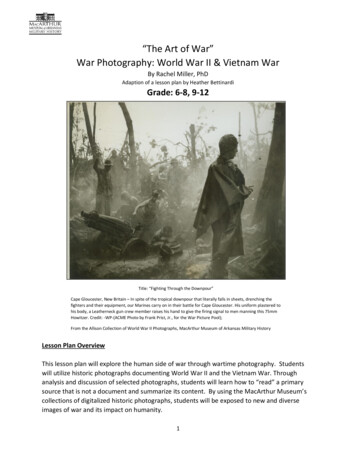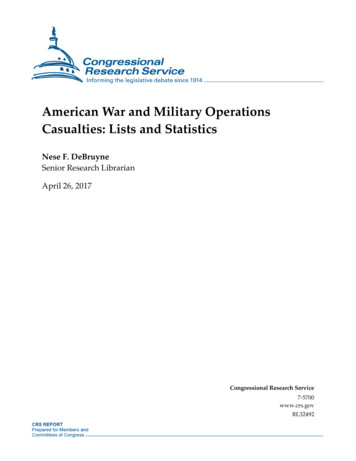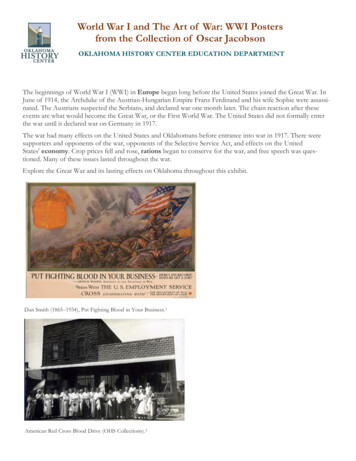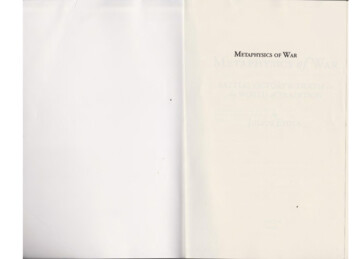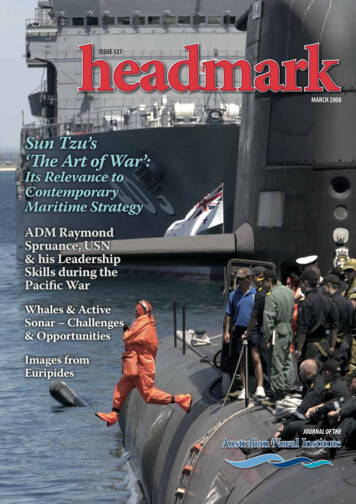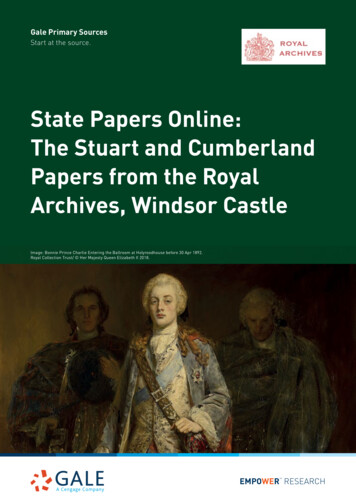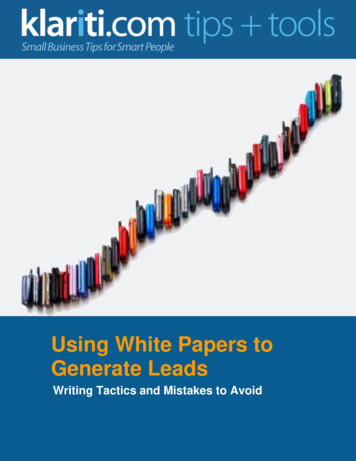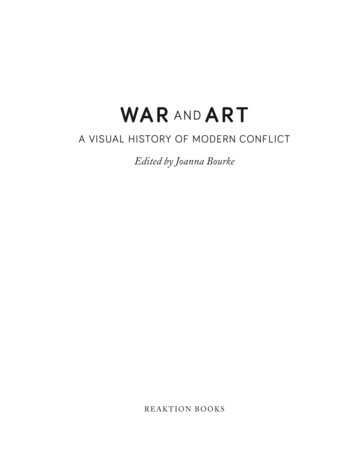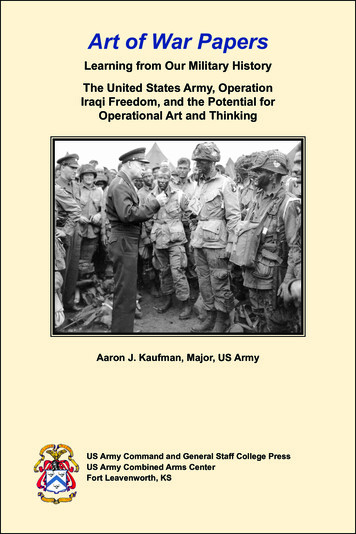
Transcription
Art of War PapersLearning from Our Military HistoryThe United States Army, OperationIraqi Freedom, and the Potential forOperational Art and ThinkingAaron J. Kaufman, Major, US ArmyUS Army Command and General Staff College PressUS Army Combined Arms CenterFort Leavenworth, KS
Learning From Our Military History:The United States Army, Operation Iraqi Freedom, and the Potentialfor Operational Art and ThinkingAaron J. Kaufman, Major, US ArmyFort Leavenworth, Kansas2013The opinions and conclusions expressed herein are those of the student author and do not necessarily represent the views of the US Army Commandand General Staff College or any other governmental agency. (Referencesto this study should include the foregoing statement.)A US Army Command and General Staff College Press BookPublished by the Army University Press
Library of Congress Cataloging-in-Publication DataNames: Kaufman, Aaron J., author. U.S. Army Command and GeneralStaff College Press, issuing body.Title: Learning from our military history : The United States Army, Operation Iraqi Freedom, and the potential for operational art and thinking /by Aaron J. Kaufman.Other titles: United States Army, Operation Iraqi Freedom, and the potential for operational art and thinkingDescription: Fort Leavenworth, Kansas : US Army Command andGeneral Staff College Press, [2017] Series: Art of war papers Includesbibliographical references. Identifiers: LCCN 2017012559 (print) LCCN 2017018043 (ebook) ISBN 9781940804422 () ISBN 9781940804422 ISBN 1940804426Subjects: LCSH: Iraq War, 2003-2011. United States. Army--History--Iraq War, 2003-2011. United States--History, Military. Adaptiveplanning (Military science) Operational art (Military science) Militaryplanning--United States.Classification: LCC DS79.76 (ebook) LCC DS79.76 .K42 2017(print) DDC 956.7044/3420973--dc23 SUDOC D 110.18:M 58LC record available at Caution-https://lccn.loc.gov/2017012559US Army Command and General StaffCollege Press publications cover a widevariety of military topics. The views expressedin this publication are those of the author(s)and not necessarily those of the Departmentof the Army or the Department of Defense.The seal of the US Army Command andGeneral Staff College authenticates thisdocument as an official publication of the US Army Commandand General Staff College Press. It is prohibited to use this officialseal on any republication without the express written permissionof the US Army Command and General Staff College Press.Edited byMichael L. Hoggiv
AbstractThis thesis began with a simple question: How was the US Army successful in OIF? As a US Army officer with two tours in OIF, I had difficulty understanding the change that occurred beginning in 2007 as a productof combat operations. Some tactical organizations, companies included,learned and adapted, whereas others accomplished little and made the environment worse. The interviews conducted as part of the Scholar’s Program and personal reflections confirmed that a deeper and more historicalunderstanding is required. I concluded that OIF demonstrated the need foroperational art and thinking, particularly in commanders of relatively junior rank. Struggling to write this thesis, I noticed my copies of the US Army’s Green Book Series on the history of World War II. Clearly, OIF lackssuch an effort. After all the effort expended in Iraq, we may ultimatelyfail in crafting our own military history in OIF in breadth and depth. Thisthesis offers an explanation on how we learned and adapted in OIF, not forthe purposes of a definitive military history, but only as an intellectual waypoint that may lead us to useful military history for the future of the Army.v
AcknowledgmentsThis thesis has proven one my life’s most challenging and rewardingendeavors. The workload of the Scholar’s Program combined with the research and writing requirements of the thesis have proven exceptionallychallenging. I certainly wish I could have finished earlier, but life in themilitary can get away. In any case, combating against my own limitationshas proven a constant source of struggle and perhaps an inordinate amountof stress. I’m thankful that it’s over.I must first thank my wonderful wife Carolin for enduring this strugglewith me, for giving me a good environment at home to think in and forthat ever-present nudge to keep going. She did this even after giving birthto my son, William, who was not yet born when this endeavor began andis now over a year old.Dr. Dan Marston has proven a fantastic mentor and professor, so Imust thank him not only for selecting me to join the Scholars but also forthe tireless shepherding through the minefield that is my easily distractedmind. Dr. Mark Hull and Dr. Nick Murray have also proven invaluable intheir advice and support during my time in the program, particularly in thewriting of the thesis.To my peers—Majors Nate Springer, Dustin Mitchell, Rob Green,Mark Battjes, Ben Boardman, Rick Johnson, and Tom Walton—I mustthank you all for the terrific and competitive learning environment thathas proven a continual source of reflection and learning on my journey tofinish this thesis.Finally, I must thank the US Army Command and General Staff College and the Army for the opportunity to participate in this program whichhas proven the most valuable experience I’ve had beyond command. Ihope to repay the favor in the future.vii
Table of ContentsAbstract.vAcknowledgments. viiChapter 1: Introduction.1Chapter 2: Doctrine, History, and Operational Art.11Chapter 3: Operational Art in Counterinsurgency.45Chapter 4: Operation Iraqi Freedom: A War of Management.73Chapter 5: Deduction from Direct Experience: General Thoughts onLearning Organizations in OIF.85Chapter 6: The Profession of Arms, Military History, and the Potentialfor Operational Art and Thinking.121Acronyms.135Bibliography.139ix
CHAPTER 1INTRODUCTIONIn 1992, the United States (US) Army’s Center of Military History(CMH) published the reader’s guide to the collection of works titled theUnited States Army in World War II. In the book’s foreword, the Chief ofMilitary History, Brigadier General Harold Nelson wrote:Since the Army authorized the project in 1946, seventy-eightvolumes have been or are being published representing an organized treasury of knowledge on the world’s greatest conflict.Behind them lies one of the largest masses of records and recollections ever produced. These documents, including thoseof the enemy, have been explored by professional historians,with the cooperation of a host of participants and with all thefacilities and assistance that the Office of the Chief of MilitaryHistory and its successor, the Center of Military History, couldprovide to ensure that this endeavor was as comprehensive, accurate, and objective as possible. The final result has providedcommanders and staff officers, historians, and students—military and civilian alike—with an unprecedented professionalguide to past experience as they seek light on the uncertainpath ahead.1Later known as the Army Green Book Series, the total effort by theUS Army in collecting, interpreting, and publishing the military historyof the war effort remains an impressive and unsurpassed institutional effort at preserving military history for the benefit of future military officersand civilian historians alike. Any study of the US Army in World War II(WWII) will invariably involve some of the military history captured inthe Green Book Series. The books remain an essential part of the militaryhistory of WWII.The history of Operation Iraqi Freedom (OIF) extends beyond a decade now. The Army has published several books on the early operationalhistory of OIF, including On Point I and On Point II, which describe thefirst 18 months of the war. The Center of Military History has publishedTip of the Spear, which highlights small unit actions, as well as Dale Andrade’s book Surging South of Baghdad, which presents a year-long operational and historical account of the 3d Infantry Division’s deployment insupport of OIF in 2007. All of these accounts relied heavily on interviews,some more timely than others, and after-action reviews (AAR).1
The sum total of accounts, however, provides little towards the creation of a total understanding of an operational and strategic military history that can descriptively explain how the Army and the war interacted and changed over time. Instead, researchers are left with proceduralhandbooks and writing on tactics written by various agencies in the Army,which fail in width, depth, and context to substitute for military history.2Out of context practical approaches thus substitute for a deeper study ofoperational thinking and strategy. Practicality, however, is thin gruel forofficers and commanders that require a broad and deep understanding ofmilitary history to act wisely in combat.3 The military history of OIF appears already defined by other narratives; ones not shaped by an Army thathas failed, so far, to collect and interpret its own history, unlike the historyof WWII as captured in the Green Books.4 This scattershot approach undermines the utility of military history.This gap in Army official history has not impeded the pursuit of histories and narratives by others that stake claims on the deterministic factorsof OIF history, on how the Army failed, succeeded, adapted, and learnedin combat. At some point, OIF history will not remain a product of benignobservation, but will transform into a tool to adjust the way the Armytrains, educates, and fights in the future. Historical interpretation willprove consequential, whether or not the Army chooses to invest the effortin collecting and writing its own war history.Many of the current accounts of the Army’s efforts in OIF rely on abaseline claim, at times assumed, on an historical argument roughly described as the rejection thesis. The rejection thesis has roots in the endof the Vietnam War, and its consequences extended into OIF. This thesisargues that Army deliberately rejected counterinsurgency, in theory andpractice, following Vietnam. The moral arguments for rejection of counterinsurgency emanated from a visceral reaction to the war and the tremendous amount of resources devoted towards a losing effort. In the end,the Army bore the heaviest cost during the war as well as the brunt ofthe political and public opprobrium following its end. The Army barelyescaped from the aftermath of Vietnam. Thus, equating counterinsurgencywith Vietnam enabled the Army and its leaders to cast off COIN with thewar itself, returning the thinking on war and warfare to its proper sphere,conventional land battle in Europe, where the true strategic interest lay.5The COIN rejection argument serves as a basis for additional narratives. Expanding from the rejection thesis, another argument assumes thedeterministic effects of doctrine, in part based on recent Army history. Therejection thesis serves as the start point. In essence, the Army reformed2
itself and restored its professionalism and reputation, in part throughtraining and education reforms, just as the Army in Iraq, burdened by itsdoctrine of decisive battles, overcame its failings through the publicationof the new COIN field manual. The main vessel for reform in each caseproved to be doctrine. The ultimate expression of the first reform effortwas the 1982 version of Field Manual (FM) 100-5, nicknamed AirLandBattle. It served as the essential source of institutional change, as the leading indicator of what the Army would become, and was vindicated in theArmy’s performance Operation Desert Storm.6 Thus, the Army requiresdoctrine to reform itself, to learn and adapt in a broad manner that leadsto success. The history of the 1970s peacetime Army is overlaid atop thewartime Army in the mid-2000s. A decade of reforms of change from 1972to 1982—the historical interpretation of the period—is projected, reworded, and compressed onto OIF, specifically over the time period of 2003 to2006. Distilled, the argument claims that the Army required new COINdoctrine to improve its performance in OIF.7Carried even further, another thesis claims that the new doctrine notonly helped reform the Army during OIF, but also served as the basis forstrategy that won the war. New doctrine shaped the tactical realm, or theconduct of the war, as well as the policy and strategy realms. It provedan indispensable factor, responsible for turning the war around. Soldiers,leaders, and policy makers alike benefitted from the efforts that went intothe new field manual, FM 3-24, Counterinsurgency.8The sum of the arguments, while certainly based on fragments of historical truth, nevertheless fails to account for how the Army learned andadapted in combat during OIF. The rejection thesis and its offspring attempt to extract too much causation from events of the last four decades, totrap the Army’s way of warfare and thinking within conventional warfaredoctrinal blinders, which began in the doctrine and training revolution ofthe 1970s. The publication of new doctrine, namely FM 3-24, strippedaway the conventional warfare blinders and exposed the collective brainof the Army to modern counterinsurgency, saving the Army from itself aswell as the strategy in Iraq.9Examples of learning and adapting leading to improved practice areoffered—such as Colonels Sean MacFarland in Ramadi and H.R. McMaster in Tal Afar—but such examples are used as exceptions to the generalarguments of Army incompetence rather than prototypes of the US Armylearning in action. Military history thus provides a few deviant examplesfor others to emulate, to intellectually sate the practitioner and to give theappearance of usefulness, as long as such stories fit into larger narratives.3
In this case, such examples are selected to provide legitimacy to largerarguments surrounding doctrine, strategy, and methods such as population-centric COIN that without them would appear monolithic, generic,overly top-down, and thus easily dismissible through a little research.10The big, general argument would die the death of a thousand particularpaper cuts, including arguments that attack the essential theory of population-centric COIN.11This version of history will prove useless to the military practitioner.Detailed understanding of particular campaigns will remain difficult, asthe same cases will surface again and again in footnotes and citations, providing little to no depth or context that can inform other theses or claims,undermining the critical role that military history serves in educating anddeveloping future commanders in the profession of arms. Operation IraqiFreedom, its historiography, will wane in utility as future officers and historians dismiss the big arguments in search of more particular detail inhistory, and due to a variety of reasons will find little available for primaryresearch, no official history like the WWII Green Book series. The valueof the history of OIF as a basis of how the Army learned and adapted overtime—beyond the glut of books on tactics, techniques, and procedures—will diminish to insignificance.12There is a better lens with which to view and interpret the history ofOIF, one that avoids the claims of big, top-down imposed narratives asoffered by the rejection thesis and its offspring, and also serves to providethe military officer more detailed context and descriptive military history.The study of operational art and thinking—based on descriptive, detailed,and available military history—should serve as the basis for understanding how the Army learned and adapted in OIF.This thesis begins by placing the study of military history as the centerpiece of officer education and development, particular for future commanders of forces in the field. It then examines doctrine in the US Armyexperience since the mid-1970s that began with men such as General William DePuy, and the tension it brought to officer development. The thesisthen goes on to examine operational art in US Army doctrine and counterinsurgency (COIN), and investigate, in depth, the writing and thinking of asenior military officer with significant experience in countering insurgencyas well a high command of conventionally-trained forces. In chapter four,we review the history of Operation Iraqi Freedom, to shape the contextof what follows, and how the war appeared in many facets a problem ofmanagement. In chapter five, we seek to identify general ideas concerninghow leaders and organizations learned and adapted while fighting in OIF,4
particularly concerning command leadership traits that may predispose anorganization to learning and adapting. This chapter makes claims based oninductive reasoning, on the synthesis of interviews with military officers,and how this informs on the necessity for operational art and thinking. Inthe final chapter this thesis demonstrates the critical linkage between thestudy of military history, command leadership, and the potential for operational art and thinking. Finally, this chapter revisits the introduction andthe critique of the rejection thesis, particular its dependence on ideas of thedeterministic effects of doctrine.In the end, the potential and usefulness for COIN doctrine is ultimately dependent on the quality of command leadership, on officer education and development. More importantly, OIF demonstrates the absolute requirement for operational art and thinking in command leadership,and better history ought to provide a basis for study, towards increasing the potential for operational art and thinking within future officers.However, this requirement needs much more particular and descriptivehistory than what is available now, histories rich in detail, personal experience, and context.5
Notes1. Richard D. Adamczyk and Morris J. MacGregor, eds., The United StatesArmy in World War II (Washington, DC: The United States Army Center forMilitary History, 1992), iii.2. The US Army places significant effort into the rapid publication of tactics,techniques, and procedures (TTP) and lessons learned. The main agency responsible for this is the Center for Army Lessons Learned (CALL), located at FortLeavenworth, KS. According to its website, the CALL “rapidly collects, analyzes,disseminates, and archives observations, insights, and lessons learned (OIL), TTP,and operational records in order to facilitate rapid adaptation initiatives and conduct focused knowledge sharing and transfer that informs the Army and enablesoperationally based decision making, integration, and innovation throughout theArmy and within the joint, interagency, intergovernmental, and multinational(JIIM) environment.” CALL manuals are ever-present items in most Army headquarters, more so than military history books or scholarly journals.3. Michael Howard, “The Use and Abuse of Military History,” RUSI Journal (February 1993), 29-30. Howard argues that three general rules of studymust be followed by the officer who studies military history as a guide in hisprofession and who wishes to avoid its pitfalls. “First, he must study in width.He must observe the way in which warfare has developed over a long historical period. Only by seeing what does change can one deduce what does not;and as much can be learned from the great discontinuities of military history asfrom the apparent similarities of the techniques employed by the great captainsthrough the ages.” Secondly, officers “must study in depth. He should take asingle campaign and explore it thoroughly, not simply from official histories butfrom memoirs, letters, diaries, even imaginative literature, until the tidy outlinesdissolve and he catches a glimpse of the confusion and horror of the real experience. He must get behind the order subsequently imposed by the historian, andrecreate by detailed study the omnipresence of chaos, revealing the part playednot only by skill and planning and courage, but by sheer good luck. Only thuscan he begin to discover, if he is lucky enough not to have experienced it at firsthand, what war is really like.” Finally, officers “must study in context. Campaigns and battles are not like games of chess or football matches, conducted intotal detachment from their environment according to strictly defined rules. Warsare not tactical exercises writ large. They are, as Marxist military analysts quiterightly insist, conflicts of societies, and they can be fully understood only if oneunderstands the nature of the society fighting them. The roots of victory anddefeat often have to be sought far from the battlefield, in political, social, andeconomic factors which explain why armies are constituted as they are, and whytheir leaders conduct them in the way they do.”4. The narratives I describe all center on the US Army in OIF and emanatefrom a central idea I call the rejection narrative, focused on the idea that theUS military, and the US Army in particular, rejected counterinsurgency afterVietnam. The rejection narrative serves as a basis for another causal narrative,6
or the doctrinal determinism narrative, which claims the US Army requiresdoctrine in order to adapt and change. The final narrative extends the deterministic effects of doctrine to the policy and strategy realms, which assertsthat, in essence, doctrine determined strategy. The narratives are essential tomaking logical leaps of three to four decades in cause and effect, and the Armymakes it easy to promote big idea narratives with moral overtones when themilitary history is thin or inaccessible.5. Colin Kahl, “The Other Side of the COIN” (Paper prepared for theInternational Studies Association Annual Convention, San Francisco, CA, 2629 March 2009), 24; Colin Kahl, “COIN of the Realm,” Foreign Affairs 86,no. 6 (November/December 2007), 169; Austin Long, On Other War: Lessonsfrom Five Decades of Counterinsurgency Research (Santa Monica, CA: RANDCorporation, 2006), 20; Austin Long, “Doctrine of Eternal Recurrence: The USMilitary and Counterinsurgency Doctrine, 1960-1970 and 2003-2006,” RANDCounterinsurgency Study, Paper 6 (Santa Monica, CA: RAND Corporation,2008), 19. Long highlights the change of thinking on the importance on largescale, third-party interventionist counterinsurgency, a loss that is understandableconsidering the context of the period; Nathaniel C. Fick and John A. Nagl, “TheUS Army and Marine Corps Counterinsurgency Field Manual: AfghanistanEdition,” Foreign Policy, no. 170 (January/February 2009), 42-43; David Fitzgerald, “Vietnam, Iraq, and the Rebirth of Counter-Insurgency,” Irish Studies inInternational Affairs 21 (2010), 151, 158; Jeffrey Record, “Review of Insurgency and Counter-Insurgency in Iraq, by Ahmed Hashim,” Middle East Policy, vol.13, no. 4 (Winter 2006), 156-158; Jeffrey Record, “Review of The US Army/Marine Corps Counterinsurgency Manual,” Middle East Policy, vol. 14, no. 3(2007), 144-145.6. Although AirLand Battle was not designed as doctrine to fight the particular enemy faced in Kuwait and Iraq.7. Kahl, “The Other Side of the COIN,” 3, 24; Long, On Other War, 1,62-63; 20; Long, “Doctrine of Eternal Recurrence,” iii, 27. Long argues thatorganizational structures, such as military organizations organized to fight peercompetitors, are both mentally and materially ill-equipped to fight insurgencies.Organizational culture borne of doctrine and tradition effectively set the limitson the ability of the military organizations to think and adapt in war. However,Long also challenges the claims of linkages between the publication of FM 3-24in December 2006 to the Army’s performance during the surge in 2007. Fick andNagl, “The US Army and Marine Corps Counterinsurgency Field Manual,” 43;Fitzgerald, “Vietnam, Iraq, and the Rebirth of Counter-Insurgency,”151; Record,“Review of Insurgency and Counter-Insurgency in Iraq,” 156-157; Record, “Review of The US Army/Marine Corps Counterinsurgency Manual,” 143.8. Fick and Nagl, “The US Army and Marine Corps CounterinsurgencyField Manual,” 42-43.9. Department of the Army, Field Manual (FM) 3-24, Counterinsurgency(Washington, DC: Government Printing Office, 2006), 1-1. The opening epigraph,attributed to a Special Forces officer in Iraq in 2005, claims that “counterinsurgen7
cy is not just thinking man’s warfare—it is the graduate level of war.” To claimthat COIN is more challenging cognitively than other forms of war is a form ofhubris that stakes a claim as to the inherent superiority of the doctrine that envelops the epigraph. War is cognitively challenging in all of its forms.10. Broadly speaking, the population-centric approach to COIN emphasizes the local population as the decisive terrain, or the center of gravity, in allcombating all insurgencies. See Department of the Army, The US Army andMarine Corps Counterinsurgency Field Manual (Chicago: The University ofChicago Press, 2007), xv. This public version of FM 3-24 has an intro written by John Nagl that describes the key to COIN is to protect the population.This is not written in the official version of the Army FM; see also OctavianManea, “The Philosophy Behind the Iraq Surge: An Interview with GeneralJack Keane,” Small Wars Journal, 5 April 2011, /726-manea.pdf (accessed 20 April 2011), 1. GeneralKeane describes the principles of population-centric COIN. Keane claims thatthe weight of military effort must be placed on securing the local populationin order to separate the insurgent from the population, in order to both defeatthe insurgency and bolster the legitimate government; see also John A. Nagl,“Let’s Win the Wars We’re In,” Joint Forces Quarterly, no. 52 (1st Quarter2009), 23. Nagl talks about the enduring principles of COIN, invoking T.E.Lawrence, Sir Robert Thompson, and Robert Komer. Nagl (and Keane) arguethat the role of coercive violence and force is subordinated to this effort, to thepoint that force and violence must be minimized in all circumstances to ensurethat popular grievances and alienation are not extended to and directed at theCOIN intervention force and thus risk the success of the COIN campaign. Asinsurgencies are essentially a form of war amongst the people, the blame andconsequences of excessive violence between the insurgent and counterinsurgent will land at the feet of the COIN force, as the insurgent is often from thepeople, both in blood heritage, culture, and traditions; see also David Kilcullen, Counterinsurgency (New York: Oxford University Press, 2010), 45. In his28 Articles, Kilcullen advocates attacking the insurgent only when he gets inthe way of your strategy, and that the COIN force should focus on attackingthe enemy’s strategy, not his forces. Addressing the drivers of popular grievance and insurgency causation, while at the same time protection the localpopulation from the violence and retribution of the insurgent, are critical todefeating the subversive political organization of the insurgent and more important than capturing or killing the militant arm of the insurgency.11. Andrew J. Birtle, US Army Counterinsurgency and Contingency Operations Doctrine, 1942-1976 (Washington, DC: US Army Center for MilitaryHistory, 2007), 424-429. One could also make the claim that Population-CentricCOIN (PC-COIN) is a recycled idea from the 1960s. Birtle’s book highlightsthat the thinking behind PC-COIN within the US Army goes back to the mid1960s, and the 1966 version of the Army’s COIN manual dedicated significantemphasis to the critical role of nation-building and power-sharing societies. Inessence, insurgencies are popular movements that are emergent, and in order8
to combat them the root problems of, among other things, social and economicinjustice, must be addressed. Thus, PC-COIN of recent thinking retains threadsthat date back to at least the mid-1960s; for anti-PC COIN arguments, seeGian P. Gentile, “Our COIN Doctrine Removes the Enemy from the Essenceof War,” Armed Forces Journal (2008), 1, http://www.armedforcesjournal.com/2008/01/3207722 (accessed 10 April 2011). The supposed antithesis ofpopulation-centric COIN is enemy-centric COIN. This idea argues that population-centric approach is a strategy that essentially assumes away the enemy,which is a critical failure in any military planning. The enemy is relatively incidental to the larger problems that drive the insurgency. The notion of the “peopleare the key” in COIN, where an abstract center of gravity substitutes for a moreconcrete center of gravity—namely the insurgent and his organization—is arecipe for extending a COIN campaign interminably and the wasting of militaryresources. See Gian P. Gentile, “Freeing the Army from the CounterinsurgencyStraitjacket,” Joint Forces Quarterly no. 58 (3d Quarter 2010), 121. In essence,the population-centric approach will inherently expose the COIN force to asymmetric attrition through the expenditure of limited resources over extended periods of time. See also, Gian P. Gentile, “Let’s Build an Army to Win All Wars,”Joint Forces Quarterly no. 52 (1st Quarter 2009), 31. Military forces in COINmust remain oriented on destroying the insurgent force, which is ultimately themost dangerous threat in any insurgency. This enemy-centric approach does notnegate the necessity for proper strategy and the requiremen
Operational Art and Thinking Art of War Papers. Learning From Our Military History: The United States Army, Operation Iraqi Freedom, and the Potential . United States Army in World War II. In the book's foreword, the Chief of Military History, Brigadier General Harold Nelson wrote: Since the Army authorized the project in 1946, seventy-eight

